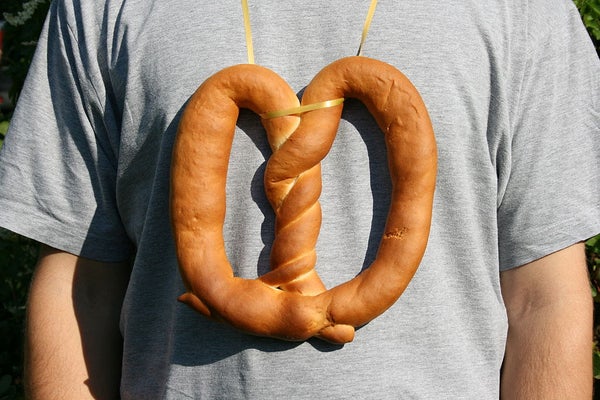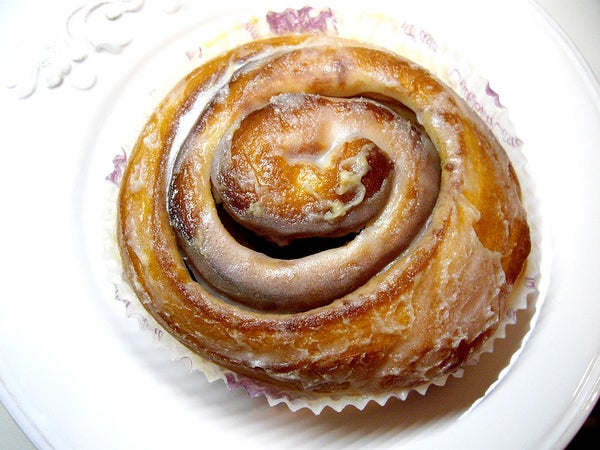Last Tuesday the Royal Swedish Academy of Sciences announced the recipients of this year’s Nobel Prize for physics: half went to David J. Thouless at the University of Washington, Seattle and half to F. Duncan M. Haldane of Princeton University and J. Michael Kosterlitz of Brown University for, in the Academy’s words, “theoretical discoveries of topological phase transitions and topological phases of matter.” Their work uses mathematical insights from the field of topology to describe and explain properties such as superfluidity and superconductivity in thin layers of fluid.
To illustrate, Nobel Committee member Thor Hans Hansson joked, “I brought my lunch.” He had packed a carbohydrate-heavy meal of a cinnamon roll, a bagel, and a pretzel. Topologists would not distinguish the pastries by taste, he said; instead, they would only care about the number of holes each one had: zero for the cinnamon roll, one for the bagel, and two for the pretzel. (In the U.S. pretzels have three holes, but some European models are more efficient.) Topology is sometimes called “rubber sheet geometry.” To a topologist, mathematical objects are made of infinitely stretchy rubber. The number of holes of an object is a topological invariant, a property that remains the same no matter how the object is stretched or squished, as long as no tearing or gluing takes place.
In contrast, basic geometry concerns itself with the finer properties of mathematical objects. While a bagel and a coffee cup are the same in topology, both having one hole, geometry can tell the difference. A bagel’s shape is fairly uniform, for example, while a coffee cup’s curves look different on different parts of the cup.
On supporting science journalism
If you're enjoying this article, consider supporting our award-winning journalism by subscribing. By purchasing a subscription you are helping to ensure the future of impactful stories about the discoveries and ideas shaping our world today.

(Huge) German pretzel: two holes. Credit: FRANK VINZENZ Wikimedia(CC BY-SA 3.0)
Geometric properties vary continuously: as you stretch out a donut or a coffee cup, its curvature changes a little bit at a time. On the other hand, topological properties change states through abrupt jumps. If you stretch a real bagel enough, it will eventually tear, yielding an object with no holes. There is never an intermediate state with half a hole. A remarkable theorem, the Gauss-Bonnet theorem, unites geometry and topology. It states that while curvature may be distributed over surfaces differently, any two surfaces with the same number of holes have the same total curvature. Over time, mathematicians, in particular Shiing-Shen Chern, generalized the Gauss-Bonnet theorem to mathematical spaces of higher dimensions and other types of curvature, broadening underlying idea of summing up a quantity over a surface to find a topological property of the surface.
The Gauss-Bonnet theorem provides a bridge between topology and physics. As adorable as it would be, the Nobel winners do not study tiny bagels and pretzels floating in super-thin materials. Instead, the Gauss-Bonnet theorem is an analogy for physical properties related to the electron energy levels in a thin film of material. The mathematical ideas are the same, but instead of curvature and holes, their work concerns the way the wavefunction varies as a function of the momentum of electrons in the film. Along with work Haldane did on one-dimensional magnetic materials, this is the part of the prize work the Academy describes as “topological phases of matter.”

Cinnamon roll, no holes. Credit: YUMI KIMURA Flickr(CC BY-SA 2.0)
The other half of the Nobel prize, awarded for “topological phase transitions,” also unites topology and physics, but “topology enters in a somewhat different way,” says Eduardo Fradkin, a physicist at the University of Illinois Urbana-Champaign.
Relevant here is the fact that topological properties often cannot be determined locally. An ant sitting on a pastry can’t tell by looking around whether the perch is a bun, bagel, or pretzel. That same idea happens in topological phase transitions. During a conventional phase transition, say liquid to gas, measuring the density in a region will tell you whether it’s liquid or gas. “You have a local measurement to tell what phase you are in,” says Marcel den Nijs, a physicist at the University of Washington, Seattle who was a coauthor on one of the papers Thouless is being honored for.
In contrast, topological phase transitions involve vortices that appear at critical temperatures in thin superconductors, superfluids, or magnets. Den Nijs compares the phenomenon to an everyday topological mystery: the parking garage. When you drive into a parking garage, “you basically go around and end up one floor higher before you know it.” The pillar in the middle that you drive around is a topological feature, the analogue of a vortex in a superfluid. “You don’t know it exists unless you walk around it,” he says.
“This was the first time that concepts of topology became relevant in condensed matter physics,” says Fradkin. “It’s a tool most physicists didn’t have before then.”
In the past ten years or so, interest in using topological properties to understand and describe physical systems has skyrocketed. One reason is the nanotechnology revolution. Real materials are catching up to to the theory, giving experimentalists a chance to observe exotic physics in action. Another reason for the enthusiasm is the potential for applications in quantum computing. Quantum computing is still mostly a theoretical model at the current time. If realized, quantum computers would replace the zeroes and ones of modern computers with quantum mechanical ways of storing information. The quantum computing analogue of bits, qubits, can be in a superposition of states rather than in a fixed state.
Because topological properties remain stable even when a system is perturbed slightly, scientists are interested in finding ways of using topology to encode information in quantum computers. Currently these topological phases of matter require enormous magnetic fields and temperatures very close to absolute zero to realize, so, as Fradkin puts it, “You won’t see a quantum laptop anytime soon.” Whether or not that quantum laptop ever materializes, ideas from topology have infiltrated physics and continue to drive both theoretical and experimental research into exotic physical properties.